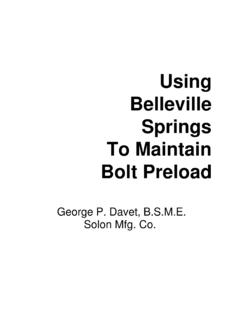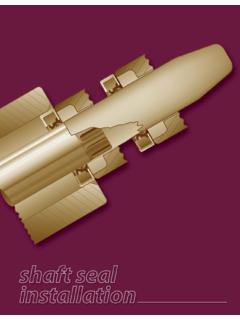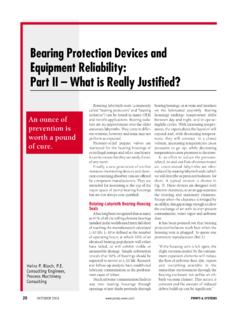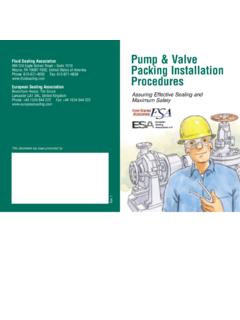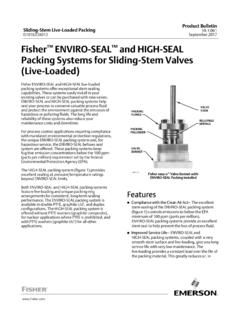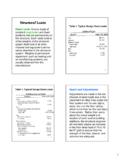Transcription of Live Loading Of Flange Joints To Prevent Leaks And …
1 live Loading Of Flange JointsTo Prevent Leaks AndReduce fugitive Flange joint Leaks have always been a problem. In the past, little was done totry to eliminate the problem. More recently new gasket materials and some new boltingtechniques have made some improvements. But in high temperature / high pressureapplications, the problem still exists. In fact, with the passage of The Clean Air Act Of1990", the problem is even more critical than , even the definition of a leak has changed. Prior to 1990, a Flange wasconsidered leaking if the leak rate was 10,000 PPM or greater. Under today s newrules, a leak must be repaired if the leak rate is 500 PPM or above. This rate can evenbe lower depending on the process in the system and varying state and only must the Flange be leak free at installation, it must maintain a leak rate of500 PPM or below for a longer period of time. This is due to the EPA s new monitoringregulations on fugitive Joints encompass conventional ANSI pipe flanges, heat exchangers headers,tube sheet, sight gages, manways, handholes, valve bonnets and almost any boltedgasketed bolted Flange joint Leaks when the material contained in the system escapesthrough the gasket pores or around the gasket and the Flange face.
2 This usually occursbecause the load on the gasket has fallen below its minimum seal pressure. Preventingflange Leaks can be a difficult task. It is necessary to maintain the contact pressureabove the minimum seal pressure between the Flange and the gasket surfaces. Thismust be done initially, as the gasket and bolts relax, and also as the temperature andpressure of the contained process changes,The initial preload can be attained by using several tried and true methods. Theproblem is maintaining this preload through the life of the joint. The following are themain factors that cause bolted Flange Joints to leak and how and why the use of SolonFlange Washers (specially engineered belleville springs for high temperature flangeapplications) can Prevent Flange Leaks and reduce fugitive Relaxation2. Gasket Creep3. Vibration4. Elastic Interaction5. Differential Thermal ExpansionEmbedment RelaxationWhen new suds and nuts are first tightened, both the stud and nut threads and thejoint contact surfaces, contact each other only on microscopic high spots.
3 These highspots will be grossly overloaded, well beyond their yield point. Therefore, plastic flowwill continue until the contact area increases sufficiently to stabilize or stop the yieldingprocess, relaxing the load on the bolt. This can account for as much as 5 - 10% loss ininitial preload. Retightening the parts can partially compensate for this type ofrelaxation. Embedment relaxation is virtually unavoidable and cannot be prevented, butyou can compensate for CreepMost gaskets are made of plastic or semiplastic materials. They must deform to dothe job intended. Like any plastic material, they will creep and flow when first subjectedto high surface loads. Most of the gaskets used today in high temperature / highpressure applications have reasonable Loading curves and fairly steep unloadingcurves. (Figure 1) Because of this, even the slightest loss in load can cause a joint tofall below the minimum seal pressure.
4 Like embedment relaxation, gasket creep 2 illustrates the effect on the unloading of a gasketed Flange joint usingbelleville springs. Solon Flange Washers compensate for the gasket relaxationsufficiently to maintain the joint compression well above the minimum seal 1 Figure 2 Bolt CreepBolted Flange Joints in high temperatureservice will have a reduction in tension due to areduction of the Young s Modulus and willrelax with time. This is in addition to the initialembedment and gasket relaxation. Figure 3illustrates this reducation in bolt tension at1000 hours versus the bolt can also be a factor causingflange Joints to leak. Loosening due to vibrationstarts at a very low rate and a very gradualrelaxation from the original preload. (Figure 4)When the preoload tension falls below a criticalvalue, the relaxation rate increases, and the nutmay even rotate and further loosen the InteractionGasketed bolted Joints should be patterntightened in stages.
5 Irregular tightening or loadingcan distort and damage the Flange and gasket. Intheory, one shouold tighten all boltssimultaneously. This is very difficult to , a more practical procedure is to tightenall the stud bolts in stages. This is usually done byusing a cross pattern sequence around the boltpattern. The first pass is tightened toapproximately 30% of the final desired second pass is done using 60% of the finalpreload, and the same bolting sequence. The third pass is done using 100% of the final preload, againusing the same Interaction is a phenomenon whichoccurs between bolts and joint members as a groupof bolts are tightened. When the first bolt in a joint istightened, the bolt is stretched and the joint Ispartially compressed. When an adjacent bolt istightened, the joint in the vicinity of the first bolt isfurther compressed. This allows the first bolt torelax. Even if a perfect initial preload had beenachieved on these bolts, only the second bolt wouldhave that preload.
6 These load losses, depending onthe stiffness of the joint, may be 50 to 60% of theFigure 3 Figure 4 Figure 5original bolt tension. Just the tightening of thesecond bolt eliminates some of the preload of thefirst bolt. The amount of the elastic interactiondepends on the size of the joint, the type ofgasket used, the distance between bolts, and thestiffness of the members. Figure 5 shows therelaxation of a single bolt using this the event all studs are tightenedsimultaneously, relaxation can and will occur afterthe final tightening. This is shown in Figure problem that occurs when tighteningbolted gasketed Joints , is the inconsistent preloadbetween all the bolts. This is thought to occurbecause of bolt relaxation and elastic inconsistency or scatter seems to be acommon problem with Joints that are tightenedusing torque 7 is a plot of the residual preload of aflange with 16 - 1 1/4 inch bolts.
7 The bolts weretorqued using the method previously were taken after each pass. Thesawtooth pattern is the result of relaxation andelastic interaction between the bolts. Thissawtooth pattern remained even after fouradditional clockwise passes at a torque of 275 8 shows an additional plot of this sameflange with bellevile springs added to each addition of the Solon Flange Washersreduces the preload scatter and nearlyeliminates the sawtooth bolt tension Thermal ExpansionAs temperatures rise most materials a Flange joint the heat is usually coming fromthe process in the system. Since the gasket andthe Flange are in closer contact with the processFigure 6 Figure 7 Figure 8stream, they heat up faster than the bolts. This means that the joint members areexpanding more than the bolts. This increases the tension in the bolts and increase theload on the extra load on the gasket compresses it more than it was during assembly,which occurred at ambient temperatures.
8 If the system cycles and the joint cools down,the joint members will return to their original thickness. Since the gasket was furthercompressed and it is not fully elastic, it cannot return to its initial compressed allows the bolt to relax, and some of the initial bolt load is this heating and cooling repeats enough times, it can reduce the initial bolt loadand gasket load to a point that the Flange will Flange Washers can be used to eliminate the effects of differential thermalexpansion. The movement in the joint is taken up by the movement of the flangewasher, and the load on the bolt and gasket will still be above its minimum additional benefit of using Solon Flange Washers is that they do not need to beretorqued after the system has come up to operating temperature. Also, some flangescan now be insulated that could not previously be are many methods used to compensate for the various factors working toreduce the initial bolt load and gasket load on a bolted joint.
9 Some are bettor thanothers, but none of them do much to maintain the loads needed to Prevent the jointfrom leaking once the system is in operation and cycling for any amount of time. SolonFlange Washers are constantly working to maintain a tight, leak free joint. Whenconsidering the alternatives, the use of Solon Flange Washers is the most economicalmethod to reduce bolted Flange joint Leaks , thus reducing fugitive Bickford, John, An Introduction To Design & Behavior Of Bolted Joints 2. Bickford, John, Ultrasonic Control Of Bolt Load , Raymond Engineering Bickford, John, Bolted Joint Which Leak , The Distributors Link, Spring, 19934. Bickford, John, That Initial Preload - What Happens To It? , MechanicalEngineering, October, 19835. Bickford, John, Bolt Torque: Getting It Right , Machine Design, June, 19906. Winter, J. Ronald, Gasket Selection - A Flowchart Appraoch , August 15, 19907.
10 Payne, Jim, Bolted Joint Improvement Through Gasket Performance Tests ,Presented at the 1992 NPRA Maintenance Conference, San Antonio, Texas8. ASM Metals Handbook, Vol. 1, Properties and Selection of Materials9. 1990 Federal Clean Air Act Amendments, (FCCA) Title 1 - Hazardous Air PollutantsFor Additional information and catalogs on Flange live Loading and valve live Loading ,contact:PO Box 207 Chardon, Ohio44024-0207800-323-9717440-286-9047 T RP 398
